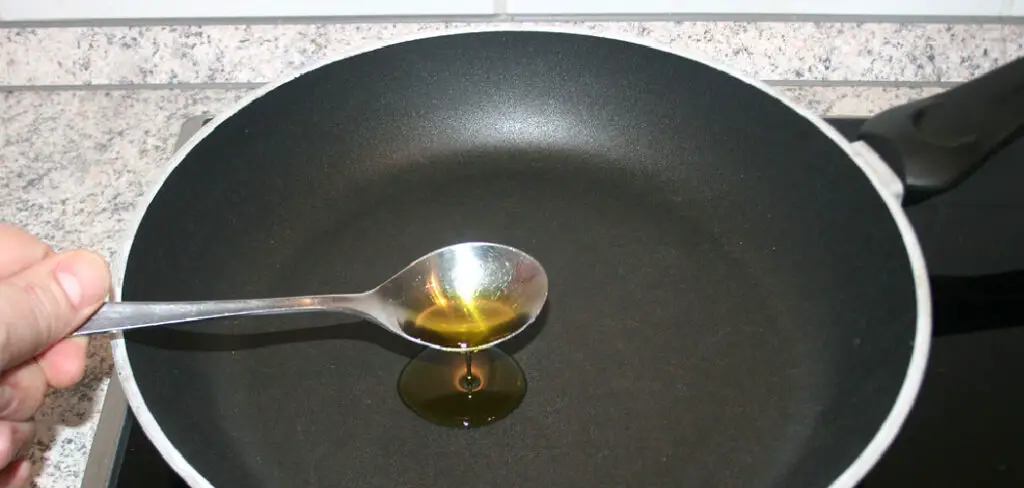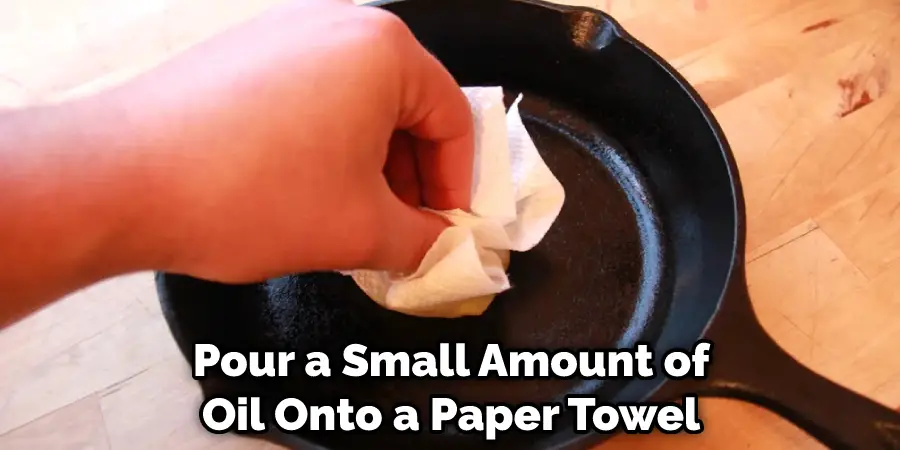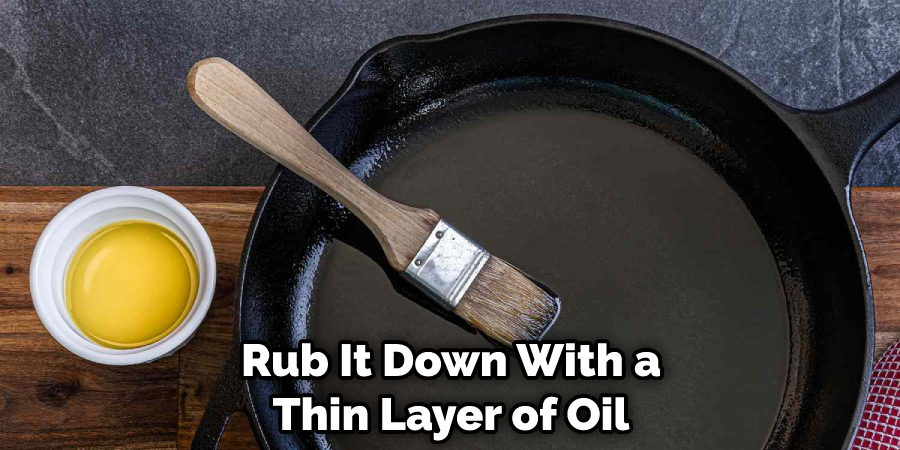Are you looking for an easier way to keep your cast iron cookware in top condition? Have you been searching for a healthy, natural, and affordable option to season your cast iron with? Look no further! Grapeseed oil is a great tool for seasoning, not only because it’s cost-effective and safe but also because it leaves behind a hard, glassy layer that creates an incredible nonstick surface.

In this blog post, we’ll provide detailed instructions on how to season cast iron with grapeseed oil. So get ready – let’s show you the benefits of using grapeseed oil for your cast iron cookware!
What is Grapeseed Oil?
Grapeseed oil is produced from the seeds of grapes, typically a byproduct of winemaking. It has a high smoke point, which means it can withstand high cooking temperatures without burning or producing harmful fumes.
Due to its neutral flavor and nutritional benefits, grapeseed oil has gained popularity in recent years as a cooking oil. It contains high levels of polyunsaturated fats and vitamin E, making it a heart-healthy choice in the kitchen.
You can easily find grapeseed oil in grocery stores or online, and it is relatively inexpensive compared to other cooking oils.
Why Use Grapeseed Oil for Seasoning Cast Iron?
Before we dive into the process of seasoning, let’s first understand why grapeseed oil is a great option. First and foremost, grapeseed oil has a high smoke point, which means it can withstand high temperatures without burning or smoking. This makes it ideal for cast iron seasoning as you’ll be heating the pan at a high temperature during the process.
In addition to its heat tolerance, grapeseed oil also has a neutral flavor and won’t leave any unwanted taste on your food. It’s also considered one of the healthiest cooking oils due to its high levels of vitamin E and omega-6 fatty acids.

Tools and Materials You Will Need to Sean Cast Iron With Grapeseed Oil:
Grapeseed Oil:
You’ll need around 2-3 tablespoons of grapeseed oil, depending on the size of your cast iron cookware. You can find grapeseed oil at most local grocery stores or online.
Paper towels or a clean cloth:
You’ll need something to spread the oil evenly on the surface of the cast iron and to remove any excess.
Aluminum foil or baking sheet:
To catch any drips during the seasoning process and to protect your oven from potential spills, it’s recommended to place aluminum foil or a baking sheet on the bottom rack of your oven.
Oven:
You’ll need an oven to heat the cast iron and allow it to form a hard, glassy layer. Make sure your oven is clean before beginning the process.
Step-by-Step Guidelines on How to Season Cast Iron With Grapeseed Oil:
Step 1: Clean Your Cast Iron Cookware
Before seasoning, it’s essential to have a clean surface to work with. If your cast iron is new, wash it with hot water and mild soap, and then dry it thoroughly. If you’re re-seasoning old cookware, make sure all the remnants of previous seasoning are removed by scrubbing it with hot water and a stiff brush. Cleaning with soap is not recommended for old cast iron, as it can strip off the seasoning.
Step 2: Preheat Your Oven

Preheat your oven to 375°F (190°C). This allows the oil to penetrate and bond with the surface of the pan effectively. This also helps to avoid uneven coating and pooling of oil. If your cast iron has a wooden handle, ensure it’s wrapped in aluminum foil to protect it from the heat. Make sure to use oven mitts when handling the pan and oven.
Step 3: Apply Grapeseed Oil
Using a paper towel or clean cloth, apply a small amount of grapeseed oil all over the surface of your cast iron cookware. Make sure to cover all areas, including the handle and sides. The layer should be thin, so if you see any pooling, wipe it away with a paper towel. While you can use a brush to apply the oil, it may leave streaks and result in uneven coating.
Step 4: Bake the Cookware
Place your cast iron cookware upside down on the top rack of your oven or on a foil-lined baking sheet. This will prevent any excess oil from dripping and creating a mess. Let it bake for an hour, then turn off the oven and allow the pan to cool completely inside before removing it. This slow cooling process ensures that the oil bonds well to the pan’s surface. If your cast iron has a wooden handle, allow it to cool completely before removing the foil.
Step 5: Repeat as Needed
For best results, repeat this seasoning process at least three times. This will create a strong and durable nonstick coating on your cast iron cookware. You may need to season more frequently if you use your cookware regularly or notice any sticking during cooking. Make sure to clean your cast iron with hot water and a stiff brush after each use, then dry it completely before reapplying a thin layer of oil.
Following these simple steps will make sure your cast iron cookware stays in top condition and provides you with healthy, nonstick cooking for years to come. So next time you’re thinking of seasoning your cast iron, give grapeseed oil a try – you won’t be disappointed!

Additional Tips and Tricks to Season Cast Iron With Grapeseed Oil:
1. When heating the cast iron skillet, make sure to use medium heat to avoid overheating and damaging the seasoning.
2. To maintain the seasoning, avoid using metal utensils when cooking in the cast iron skillet. Instead, use wooden or silicone utensils.
3. After cooking, clean the skillet with mild soap and warm water. Avoid using harsh scrubbers as they can strip away the seasoning.
4. If food is stuck on the skillet, fill it with water and bring it to a boil on the stove. This will help loosen any stubborn bits without causing damage to the seasoning.
5. To prevent rust from forming on your cast iron skillet, make sure to dry it completely after washing it.
6. If you notice that your cast iron skillet’s seasoning is starting to fade, you can re-season it by following the same steps mentioned earlier.
7. Don’t be afraid to experiment with different oils for seasoning your cast iron skillet. While grapeseed oil is a great option, other high-smoke point oils like avocado or coconut oil can also work well.
8. When storing your cast iron skillet, make sure it is completely dry and lightly coat it with oil to prevent rusting.
9. In addition to stovetop cooking, cast iron skillets are also great for baking in the oven. Just make sure to preheat the skillet before adding any ingredients.
10. Lastly, don’t be discouraged if your first few attempts at seasoning your cast iron skillet don’t turn out perfectly. It takes practice to get the perfect seasoning, and each skillet may require a slightly different process.
Following these additional tips and tricks will help you maintain a well-seasoned and high-quality cast iron skillet for all your cooking needs. Remember to handle the skillet with care, avoid harsh chemicals, and always use the right tools for cooking in order to preserve its seasoning. With proper care and maintenance, your cast iron skillet can last for generations to come. Happy cooking!

Precautions Need to Be Followed for Seasoning Cast Iron With Grapeseed Oil:
1. First, make sure that the cast iron is completely clean and dry before beginning the seasoning process. Any moisture or food particles left on the surface can hinder the effectiveness of the oil in creating a non-stick coating.
2. Use grapeseed oil specifically for seasoning as it has a high smoke point and does not leave a sticky residue like other oils such as olive or vegetable oil.
3. Heat your oven to 375 degrees Fahrenheit (190 degrees Celsius) while you prepare the cast iron for seasoning.
4. Apply a thin layer of grapeseed oil to all surfaces of the cast iron using a paper towel or cloth. Make sure to cover every nook and cranny, including handles and sides.
5. Place the cast iron upside down on the top rack of your oven to catch any excess oil that may drip off.
6. Bake for one hour, then turn off the oven and let the cast iron cool inside for several hours or overnight.
7. Repeat this process at least two more times, or as needed, until a smooth and shiny black coating is achieved on the cast iron surface.
8. Always use caution when handling hot cast iron and make sure to wear oven mitts or protective gloves while handling it during the seasoning process.
Following these precautions will ensure that your cast iron is properly seasoned with grapeseed oil and ready for use in your kitchen. It’s important to note that this process may need to be repeated periodically, especially if the non-stick coating starts to wear off. With proper maintenance and care, your seasoned cast iron will last for generations and provide you with delicious meals for years to come. So go ahead and get cooking! Happy seasoning!
Do You Need to Use Professionals?
No, you do not need to use professionals for seasoning your cast iron with grapeseed oil. This is a simple and straightforward process that can easily be done at home with the right materials and precautions. However, if you are unsure about how to properly season your cast iron or have any concerns, it’s always best to consult a professional or follow instructions from trusted sources. With a little practice and patience, you can easily master the art of seasoning cast iron with grapeseed oil and enjoy all the benefits it has to offer. So why wait? Grab your cast iron skillet and get ready to create some delicious meals today!
How Much Will It Cost?
Seasoning your cast iron with grapeseed oil is a cost-effective process as the main ingredient, grapeseed oil, is relatively inexpensive and can be used for multiple rounds of seasoning. You may also already have it in your kitchen pantry. The cost will depend on the brand and quantity of grapeseed oil you choose to use.
Additionally, you may need to factor in the cost of running your oven for an hour each time you season your cast iron. However, this cost is minimal compared to the long-term benefits and savings that come with owning a well-seasoned cast iron skillet. So don’t let cost be a deterrent, and start seasoning your cast iron today!
You can also consider looking for second-hand or vintage cast iron skillets, which are often cheaper and may already have some level of seasoning on them. Just make sure to thoroughly clean and re-season them before use.
Frequently Asked Questions:
Why is It Important to Season Cast Iron?
Seasoning cast iron helps create a naturally non-stick surface that prevents food from sticking, making it easier to cook and clean. It also protects the pan from rusting and extends its lifespan. The seasoning process involves creating a layer of polymerized oil that bonds to the cast iron and creates a smooth and durable coating.
What kind of oil should I use to season cast iron?
Grapeseed oil is an ideal choice for seasoning cast iron due to its high smoke point. This means it can withstand high temperatures without breaking down and becoming sticky or rancid. Other oils with high smoke points include avocado oil, flaxseed oil, and canola oil. You want to avoid using oils with low smoke points, like olive oil or butter, as they can cause the cast iron to become sticky and unevenly seasoned.
Can I Use Any Type of Grapeseed Oil for Seasoning?
Pure, organic grapeseed oil is recommended for seasoning cast iron. This type of oil has a neutral flavor and is free from any additives or chemicals that may affect the seasoning process. It’s also important to make sure the oil is fresh and not past its expiration date. Using old or rancid oil can result in a sticky and uneven coating on your cast iron.
Can I Use My Cast Iron Skillet Right After Seasoning?
No, it’s important to let the cast iron cool inside the oven after seasoning. This allows the oil to fully polymerize and create a strong coating on the surface of the skillet. Using or washing the skillet too soon after seasoning can cause the coating to become damaged or uneven. The longer you let it cool, the better the seasoning will be.
How Often Should I Reseason My Cast Iron Skillet?
It is recommended to reseason your cast iron skillet whenever you notice the non-stick coating starting to wear off or if there is any rust forming on the surface. This can vary depending on how often you use your skillet and how well you maintain it. With proper care, your cast iron skillet may only need to be reseasoned once every few months or even years. You can also periodically touch up the seasoning by lightly coating the skillet with oil and heating it in the oven for a shorter duration.
Can I Use Soap to Clean My Cast Iron Skillet?
Contrary to popular belief, using soap is not harmful for properly seasoned cast iron. However, it’s important to avoid harsh chemicals and abrasive scrubbers that can strip away the seasoning. It’s best to use mild soap and warm water and only scrub with a soft sponge or brush. After washing, make sure to dry the skillet thoroughly and apply a thin layer of oil for protection.
Can I Cook Acidic Foods in My Cast Iron Skillet?
It is generally not recommended to cook highly acidic foods, such as tomatoes or citrus fruits, in cast iron. The acid can react with the iron and cause off-flavors in the food. However, if your cast iron is well-seasoned and maintained, it can withstand occasional use with acidic ingredients. Just make sure to clean and dry the skillet thoroughly afterward and reapply a layer of oil for protection.
Conclusion:
All in all, knowing how to season cast iron with grapeseed oil is an essential skill for any home cook. It not only enhances the cooking experience but also ensures the longevity of your cast iron pan. With proper care and maintenance, a seasoned cast iron pan can last for generations to come. So don’t be afraid to get creative and experiment with different recipes in your well-seasoned cast iron pan! Remember, practice makes perfect, so keep seasoning and cooking with grapeseed oil to achieve a perfectly seasoned cast iron skillet. Happy cooking!
Professional Focus
Angela Ervin, a former interior designer turned blogger, specializes in kitchen design and renovations. Through her website, she blends her passion for cooking with design expertise, sharing practical and creative ideas. Known for balancing functionality and beauty, Angela’s insightful content has made her a trusted voice in home design and lifestyle.
About the Author
Angela Ervin, an experienced interior designer and blogger, combines her passion for kitchen renovations with storytelling. Living in Petersburg with her family, she enjoys cooking and testing her projects firsthand. Known for her humor and relatable style, Angela shares creative, functional design insights through her content, making her a trusted voice in home design.
Education History
University: Virginia Commonwealth University
Degree: Bachelor of Fine Arts (BFA) in Interior Design
- Angela’s education at VCU focused on mastering core interior design principles, including spatial planning, color theory, materials selection, and sustainable design practices.
- She gained hands-on experience through studio projects and collaborative design exercises, which honed her ability to create functional and aesthetically pleasing environments.
- Her coursework also emphasized problem-solving and practical applications of design, preparing her for real-world projects like her self-directed kitchen renovations.
- The program’s strong foundation in both technical skills and creative expression shaped Angela’s ability to seamlessly integrate form and function in her work.


